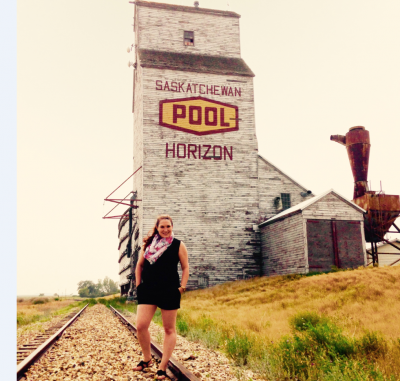Grad Research: The Rise and Fall of Wooden Grain Elevators
When Ali Piwowar was 10, her family moved to Regina, Saskatchewan. And that’s when her fascination with wooden grain elevators began. Elevators dotted the horizon as far as the eye could see.
Piwowar wondered: “Why were there so many? Why did they all look almost identical? What was going on behind those walls?

Today, most of the original 3,000 elevators in Saskatchewan are gone.
Piwowar decided this would make an intriguing thesis topic while she pursued her Master in Architecture (March) through the Azrieli School of Architecture and Urbanism.
She found out that grain elevators were demolished for two main reasons. The grain companies who owned them no longer needed them because the new concrete inland grain terminals are more efficient. Secondly, there is a cost to maintaining any building and, without providing necessary updates, the structure becomes a liability.
“This is a sign that the family farm in Saskatchewan is becoming less feasible in the face of larger farming corporations,” shares Piwowar. “However I think a major reason so many are gone is because no one knows what else to do with them.”
And so Piwowar focused on this research question: “Why are wooden crib grain elevators important to Saskatchewan’s evolving culture and how could they be adapted for future use?”
Historically, a grain elevator was both a physical and social centre for rural prairie communities. Says Piwowar: “It anchored the town in the vast landscape and visually created an axis between Main Street and Railway Avenue (in almost every prairie town). Farmers gathered at the elevator even when they weren’t trading grain.”
While there is little activity around the wooden grain elevators today, Piwowar says they stand as monuments to this past way of life.
“You can feel that something is missing in a town that no longer has an elevator,” she says. “Losing the elevator means a loss of individual and communal identity.”
Piwowar says she is aware of communities who hear that their grain elevator is coming down; raise a lot of money to buy it; and then don’t know what to do with it.
Her thesis provides some possible solutions.
She chose to do a case study of a small Saskatchewan town called Indian Head, which at one point had 12 elevators and a flourmill to handle the grain.

Her specific design project showcased how one particular elevator could be used for a community garden, community kitchen, tourist information centre, community gathering space, two hotel suites, and a coffee shop.
She says this demonstrates that any grain elevator has potential for reuse as other grain elevators could be used for similar or other spaces e.g. for offices, retail space, library and archives, or even residential units.
Adds Piwowar: “The two most important aspects in re-imaging grain elevators are that the process and programming are community-driven and that the elevator is given a new life that makes it a destination.”
“It is also imperative that the grain elevator maintains its monumentality through its original form and character-defining elements. This includes the window design, new building envelope design, and the new doorways, floors, and stairs on the interior of the structure.”
Piwowar applauds her former advisor Stephen Fai, the director of the Carleton Immersive Media studio (CIMS). “His interest in historical construction techniques in addition to growing up in Saskatchewan, made him the perfect choice for my thesis advisor. Throughout my thesis year, he was very patient, asked the right questions, and guided my research and design work to ensure the final product was comprehensive, innovative, and that it balanced practicality with imagination. I couldn’t have done it without him!”
Having graduated in June, Piwowar is now hoping to collaborate with communities and organizations to bring her ideas to life. She is already booked to run a two-day series of presentations and workshops with both children and adults in re-designing their 100-year-old wooden grain elevator. She will also be presenting at the Heritage Canada National Conference in Calgary in October.